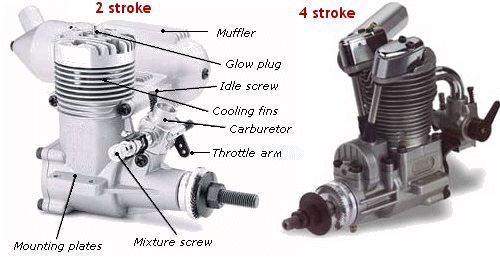
Two-stroke glow engines are by far the most popular engines used to power RC model airplanes. They are relatively inexpensive for the power they produce, they are easy to start, run and maintain, and once you learn how to properly take care of them they will last for many years. Let’s take a closer look. All model kits and ARFs have a recommended engine size range. Typically this will be something like.25 to.32, or.40 to.60, etc. You should choose an engine that is within this range, and for better climb performance you should pick an engine closer to the higher side of the range. When it comes to choosing a propeller for your engine, you should also follow the recommendations found in the engine’s operation guide.
ENGINE SPEAK If you have never owned or run a 2-stroke engine then some of the terminology needs to be explained. Here’s a glossary of 2-stroke engine terms: ABC: refers to the materials that make up the engine’s piston and sleeve; an aluminum piston (A), fitted into a brass sleeve (B), that has been chrome plated (C). Case: the engine’s main body. Most are cast in one or two parts from aluminum, though some specialty engines are made from fully-machined aluminum stock.
Connecting rod: also referred to as a con rod, this is the part of the engine that connects the piston to the crankshaft. The con rod has bushings at each end and is connected to the piston with the wrist pin (top end), and is connected to the crankshaft with the crank pin (bottom end). Cylinder head: the top part of the engine usually bolted into place with either four or six bolts or screws. A threaded hole in its center is where the glow plug is installed. The underside of the cylinder head is machined to form the top of the combustion chamber. Ports: openings and channels machined into the sleeve and engine case that allow the transfer of the air/fuel mixture from the engine case into the combustion chamber and, after combustion, out through the exhaust.
Shaktimaan serial title song lyrics mp3 list. Discussion 2 stroke glow cylinder head temperatures Engines. Use a little castor, use a fatter needle setting (on 4-stroke or 2-stroke) - open the needle until it starts to miss, then lean it until it *just*runs clean without a miss.
Sleeve: the cylinder’s internal lining or liner. A tubular, brass structure that houses and guides the piston, the sleeve has a flat rim flange that fits between the engine case and cylinder head to hold it in place. Port openings are machined in the side of the sleeves that align with the transfer channels in the engine case.
ENGINE ASSEMBLY With most engines, the case usually has three parts: the front housing that houses the crankshaft and main bearings, the crankcase that is the main case that the cylinder is attached to, and the back plate that seals the back of the engine. It is usually held in place with four bolts or screws and can be sealed with either a thin gasket or an internal O-ring.
The crankcase is supported in the front housing with a large rear bearing and a smaller front bearing. In less expensive engines, solid bronze bushings can be used in place of the ball bearings. A prop nut and a thrust washer hold the prop securely to the front end of the crankshaft and at the rear is a large counter-weighted web and crankpin used to connect the crankshaft to the conrod. The conrod is attached to the piston with the wrist pin and the piston fits within the sleeve, which fits into and is supported by the cylinder part of the engine case. The head fits on top of the sleeve and the space between the top of the piston and the bottom of the head forms the combustion chamber.
Depending on the design of the engine, the piston can be sealed with either a piston ring that fits between the piston and the sleeve, or the piston can be sealed with a slight taper (smaller at the top) in the sleeve. This is how an ABC engine is set up.
CARBURETOR The engine’s power is controlled by its carburetor. The carburetor is made up of the main body, the throttle barrel, the high-end and low-end needle valve assembly, the spray bar and the venturi. Air enters the carburetor through the venturi opening and the amount of air is controlled by the rotating throttle barrel.

A throttle arm is attached to the barrel so it can be rotated open and closed by the throttle linkage and servo. The fuel enters the venturi through the high-end (main) needle valve and it sprays into the venture through a hole in the side of the spray bar. By turning the main needle valve in (clockwise) you lean out the fuel air mixture by lessening the amount of fuel relative to the air. By turning it counterclockwise you richen the mixture by letting more fuel flow in. The low-end (idle) needle valve is usually located at the center of the carburetor’s throttle arm and it adjusts the mixture while the engine is operating at idle to about throttle. It may require a thin screwdriver to adjust. GLOW PLUG The glow plug is used to ignite the fuel mixture within the combustion chamber.
